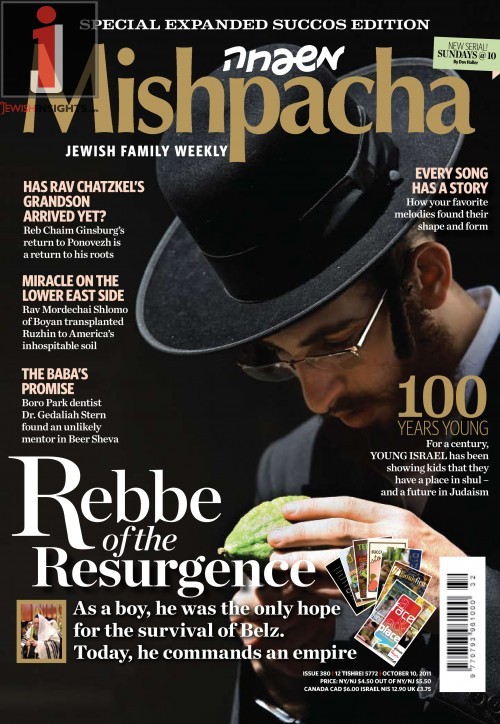MISHPACHA MAGAZINE presents:The Story Behind the Song

The Story Behind the Song
Every song has a story — and many stories are linked to song. From the classic “oldies” to the newer additions, here are the stories behind 10 of your musical favorites
By Avi Kalmarsky
Photos Ouria Tadmor
Song and melody are an intrinsic aspect of the Jewish heart and soul — especially when the song is linked to an uplifting story. In fact, some of the most famous melodies in the modern-day musical repertoire have backstories no less inspiring and poignant than the tunes themselves. On this musical journey, 10 songs take a sideline as the stories are cast in a starring role.
Lyrics & Legends
Kad Yasvin
1980. The lecture hall was filled to capacity, as a varied group of scholars gathered for the Jerusalem Yarchei Kallah. An esteemed rosh yeshivah from Yerushalayim took his place at the speaker’s podium and introduced his topic — the analysis of an ancient song, sung by Jews across the globe, whose source is hazy: “Kad Yasvin Yisrael.”
The stirring song is sung at several occasions on the Jewish calendar, most prominently on Shavuos and Simchas Torah. It’s famous not only because of its potent lyrics, but also because of its emotive melody. But its history is filled with question marks. Who composed its famed lyrics and melody? When was it first shared with the public?
During that Yarchei Kallah conference three decades ago, the rosh yeshivah quoted the words of this exceptional niggun. At the end of his speech, he challenged his audience to uncover the roots of this song. “Whoever manages to do so, I’ll address with the title of ‘Mori v’Rabi,’” he added.
Sitting in the audience was Jerusalemite researcher Yisrael Gellis, who resolved to accept the challenge. Following five years of research, Gellis finally unearthed an ancient machzor called “Machzor Vilna HaRishon — The First Vilna Machzor.” Beneath the text of hakafos for Simchas Torah, he discovered the words of this famous song: “Kad yasvin Yisrael — When Yisrael engages in the joy of the Torah, HaKadosh Baruch Hu tells His heavenly court, ‘Look and see My dear children who forget their tribulations and engage in my beloved [Torah].’” The inscription was followed by a comment that the lyrics had been created by none other than the Vilna Gaon. According to the notes in the machzor, the Vilna Gaon sang these words each and every year during the third hakafah on Simchas Torah.
Throughout the course of his research, Gellis also encountered a Yerushalmi talmid chacham named Rav Kalman Landau, a rosh yeshivah in Tchebin, who had heard the same song sung by the Chazon Ish ztz”l. The Chazon Ish recalled this song from his small hometown of Karelitz, located between Vilna and Eishyshok on the border of Belarus and Lithuania.
Friday Night at the Rebbe
Eishes Chayil
Reb Ben Zion Shenker, also known as the “voice of Modzitz,” has been sharing his gift for over half a century. His compositions range from tefillos to zmiros to some of the most popular songs played at weddings and special events.
Undoubtedly, one of his most famous masterpieces is “Eishes Chayil,” now sung in tens of thousands of Jewish homes every Friday night. Reb Ben Zion composed this song in honor of his wife, Dina, immediately after their marriage; yet the fascinating story behind it dates back to the sacred court of the Rebbe Imrei Shaul of Modzitz zy”a, whom Reb Ben Zion revered and served as court composer.
After his escape from the Nazi menace, the Imrei Shaul settled in New York. There, the Shenker family, led by Reb Ben Zion’s father, Reb Mordechai Shenker, was drawn to his holy court and went to meet the Rebbe in his new home. The Shenkers were awed by this holy figure, and they became Modzitzer chassidim. In time, young Ben Zion, drawn to the world of music and melody from an early age, was selected as the composer and singer for the holy court of Modzitz.
An ardent chassid, Reb Ben Zion participated in the Rebbe’s tisch every Friday night. Every Erev Shabbos, prior to singing “Shalom Aleichem,” the Rebbe would recite the words of “Eishes Chayil,” spicing it with his own special nusach. It wasn’t an actual tune, recalls Reb Ben Zion, but more of an intonation that fit perfectly with the words that the Rebbe hummed as he made his way around the room. Over time, the Rebbe’s family and chassidim learned to hum along with their Rebbe, and after his marriage, Reb Ben Zion transformed the Rebbe’s intonation into a full-fledged song that has graced Shabbos tables across the world ever since.
Reb Ben Zion once remarked that since composing “Eishes Chayil,” he loves passing by the open windows of Jewish homes in New York on Friday nights and hearing the song sung by families, young and old. “It’s the greatest nachas possible,” he says proudly.
For the rest of the article please pick up this weeks Mishpacha or visit them on the web
cover of this issue
Related Articles
Nachman Bowmel In A New Single In Honor of Shabbos: “Lecha Dodi”
Nachman Bowmel releases a new single in honor of the holy Shabbos “Lecha Dodi“. A new tune on the ancient
Yossi Frankel Presents: Elad Eldad “Simcha La’Chassan V’LaKallah Medley”
Elad Eldad is releasing a brand new medley called the “Simcha La’Chassan V’LaKallah” Medley. The medley was arranged and produced
Exciting Electro-Pop With Chasidic Touches – David Ben Arza In A New Single
After “Rachamim“, “Lechu Mayim” and “Nes” David Ben Arza releases the last single before the release of his debut album






